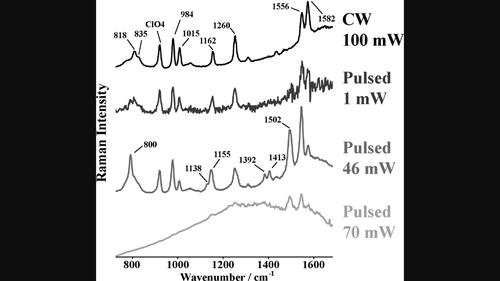当前位置:
X-MOL 学术
›
J. Raman Spectrosc.
›
论文详情
Our official English website, www.x-mol.net, welcomes your feedback! (Note: you will need to create a separate account there.)
Continuously wavelength tunable, continuous wave laser ideal for UV Raman spectroscopy
Journal of Raman Spectroscopy ( IF 2.5 ) Pub Date : 2023-11-20 , DOI: 10.1002/jrs.6622 Ryan D. Roppel 1 , Sanford A. Asher 1
Journal of Raman Spectroscopy ( IF 2.5 ) Pub Date : 2023-11-20 , DOI: 10.1002/jrs.6622 Ryan D. Roppel 1 , Sanford A. Asher 1
Affiliation

|
We utilize a novel, high-power, tunable, continuous wave (CW) deep UV laser to measure resonance Raman spectra of phenolate solutions with high signal-to-noise ratios (SNR). In UV resonance Raman (UVRR), increased coupling of the excitation light with a chromophore can transfer molecules into excited states that cause increased heating and photochemistry. Deep UV lasers have traditionally utilized high peak powers to enable efficient single-pass nonlinear conversion from visible into near infrared light. Nonlinear phenomena such as the formation of transient radical species, Raman saturation, thermal heating, and dielectric breakdown can introduce extraneous light sources that can complicate the interpretation of the Raman spectrum. Dielectric breakdown can increase the baseline, increase noise, and sometimes saturate the detector, preventing Raman detection. Spontaneous Raman scattering intensities should scale linearly with the excitation light intensity. However, this linear behavior does not always occur with pulsed laser excitation. This occurs because stimulated Raman scattering can cause a superlinear intensity response, or transient absorption can cause sublinear intensity responses. CW laser excitation excites samples with electric fields that are much lower than typical pulsed laser excitation. This eliminates the nonlinear responses. The geometry of our new CW laser enables high gain in the harmonic generation cavities that achieve high harmonic generation efficiencies. Average power in the deep UV is >30 mW for wavelengths as short as 206 nm. In the work here, we demonstrate that CW excitation is ideal for resonance Raman measurements in general to reduce spectral complexity.
中文翻译:

连续波长可调、连续波激光器,非常适合紫外拉曼光谱
我们利用新型、高功率、可调谐、连续波 (CW) 深紫外激光器来测量具有高信噪比 (SNR) 的酚盐溶液的共振拉曼光谱。在紫外共振拉曼 (UVRR) 中,激发光与发色团的耦合增加可以将分子转移到激发态,从而导致加热和光化学作用增强。深紫外激光器传统上利用高峰值功率来实现从可见光到近红外光的高效单程非线性转换。瞬态自由基物质的形成、拉曼饱和、热加热和介电击穿等非线性现象可能会引入无关光源,从而使拉曼光谱的解释变得复杂。电介质击穿会增加基线、增加噪声,有时会使检测器饱和,从而妨碍拉曼检测。自发拉曼散射强度应与激发光强度成线性比例。然而,这种线性行为并不总是在脉冲激光激发时发生。发生这种情况是因为受激拉曼散射可能导致超线性强度响应,或者瞬态吸收可能导致亚线性强度响应。连续激光激发用比典型脉冲激光激发低得多的电场来激发样品。这消除了非线性响应。我们的新型连续波激光器的几何形状可在谐波发生腔中实现高增益,从而实现高谐波发生效率。对于短至 206 nm 的波长,深紫外线的平均功率 >30 mW。在这里的工作中,我们证明了 CW 激发对于一般共振拉曼测量来说是理想的,可以降低光谱复杂性。
更新日期:2023-11-20
中文翻译:

连续波长可调、连续波激光器,非常适合紫外拉曼光谱
我们利用新型、高功率、可调谐、连续波 (CW) 深紫外激光器来测量具有高信噪比 (SNR) 的酚盐溶液的共振拉曼光谱。在紫外共振拉曼 (UVRR) 中,激发光与发色团的耦合增加可以将分子转移到激发态,从而导致加热和光化学作用增强。深紫外激光器传统上利用高峰值功率来实现从可见光到近红外光的高效单程非线性转换。瞬态自由基物质的形成、拉曼饱和、热加热和介电击穿等非线性现象可能会引入无关光源,从而使拉曼光谱的解释变得复杂。电介质击穿会增加基线、增加噪声,有时会使检测器饱和,从而妨碍拉曼检测。自发拉曼散射强度应与激发光强度成线性比例。然而,这种线性行为并不总是在脉冲激光激发时发生。发生这种情况是因为受激拉曼散射可能导致超线性强度响应,或者瞬态吸收可能导致亚线性强度响应。连续激光激发用比典型脉冲激光激发低得多的电场来激发样品。这消除了非线性响应。我们的新型连续波激光器的几何形状可在谐波发生腔中实现高增益,从而实现高谐波发生效率。对于短至 206 nm 的波长,深紫外线的平均功率 >30 mW。在这里的工作中,我们证明了 CW 激发对于一般共振拉曼测量来说是理想的,可以降低光谱复杂性。



























 京公网安备 11010802027423号
京公网安备 11010802027423号